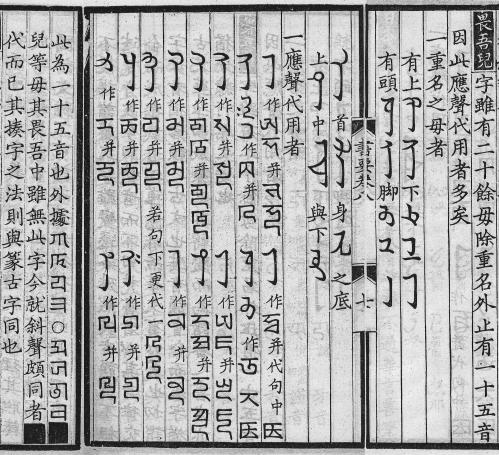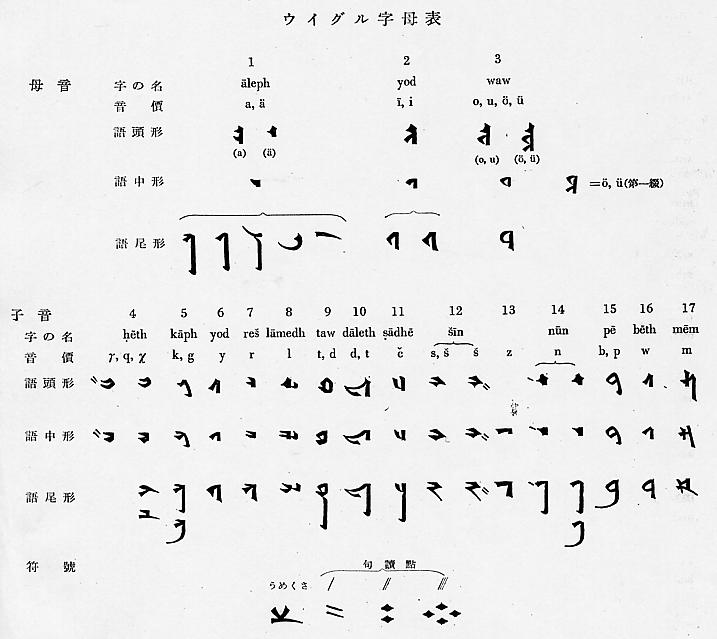
In his work on calligraphy, Shūshǐ Huìyào 書史會要, the late Yuan / early Ming author Tao Zongyi 陶宗儀 gives a description of the Old Uighur script in which he uses Phags-pa letters to describe the pronunciation of the letters of the Uighur script.
This is a very important document, as the only other contemporary description of the Old Uighur script is the "Turkic Dictionary" of Mohamed Kashgari (1008-1105), which gives 18 Old Uighur letters glossed in the Arabic script. Taking into account the fact that Tao Zongyi merges together some of the homographic letters counted separately by Mohamed Kashgari, the only substantial difference between the two works is that Tao Zongyi does not include an Old Uighur letter z. The reason for this is that Tao Zongyi's description of the Old Uighur script postdates that of Mohamed Kashgari by some three hundred years, and the language that the script represents may well have changed over this period of time.
Tao Zongyi's description of the Uighur script is also discussed by Professor Junast (Junast 2000).
Please note that the Old Uighur script has not yet been encoded in Unicode, but as its letters are largely similar or identical to the letters of Mongolian (which derived from the Old Uighur script), the corresponding Mongolian letters have been substituted for the original Old Uighur letters where appropriate on this page (the Mongolian letters should be displayed if you have the latest version of the Code2000 font or the SimSun-18030 or STFangsong font installed on your system). Note also that the original Old Uighur letters given by Tao Zongyi are very badly formed, and a certain amount of interpretation is needed to deduce which letter is actually meant. A table of Old Uighur letters used in the Uighur text inscriptions at Juyong Guan 居庸關 is given in Illustration 2 at the bottom of this page.
Tao Zongyi's description of the Old Uighur script is transcribed and translated below, but due to the lack of current support for the Old Uighur and Phags-pa script, the tables of Uighur letters (see facsimile below) have not been transcribed or translated. The correspondence between Uighur letters and Phags-pa letters given by Tao Zongyi is summarised in Table 1 after the translation.

Source : Shushi Huiyao 書史會要 vol. 8 folio 7a-8a.
畏吾兒字雖有二十餘母,除重名外止有一十五音。因此應聲代用者多矣。
一、重名之母者:
[See Illustration 1]
一、應聲代用者:
[See Illustration 1]
此為一十五音也。外據ꡀ、ꡌ、ꡑ、ꡙ、〇、ꡖ、ꡕ、ꡔ、ꡄ■兒等母,其畏吾中雖無此字,今就斜聲頗同者■代而已。其揍字之法則與篆古字同也。
Although the Uighur script comprises twenty or so letters, when you discount those letters which have more than one name (i.e. letters that have the same graphic form as other letters) there are just fifteen "sounds" (i.e. fifteen distinct graphic forms excluding positional variants). Because of this there are many letters which represent more than one sound.
1. Letters with more than one name :
[See Illustration 1]
2. Letters that represent more than one sound :
[See Illustration 1 and Table 1]
These are the fifteen "sounds". In addition to these letters, there are [the sounds represented by the Phags-pa letters] KA, TA, PHA, ZA, DZA, TSHA, TSA and CA. Although there are no letters for these sounds in the Uighur script, they can be represented by Uighur letters which have similar related sounds. The method of joining the letters together is the same as used for seal-script form ancient letters (i.e. the Uighur-derived Mongolian script ?).
| Uighur Letter | Phags-pa Letter | Phags-pa Transcription | Notes |
|---|---|---|---|
| ᠠ | ꡝ ꡠ ꡜ ꡜꡦ | A and E HA and HEE | As the Phags-pa letter EE does not occur initially, initial Uighur e is represented by the Phags-pa letter E |
| ᠸ | ꡤ ꡓ | FA (initial) W (medial) | |
| ᠬ | ꡢ ꡖ | QA -A | |
| ᠤ | ꡟ ꡡ ꡓ | U and O W | |
| ᠰ | ꡛ ꡛꡦ | SA and SEE | |
| ᠵ | ꡗ ꡗꡦ ꡆ ꡆꡦ | YA and YEE JA and JEE | This letter should also represent the vowel i |
| ᠺ | ꡂ ꡂꡦ ꡁ ꡁꡦ | GA and GEE KHA and KHEE | |
| ᠲ | ꡊ ꡊꡦ ꡉ ꡉꡦ | DA and DEE THA and THEE | |
| ᠮ | ꡏ ꡏꡦ | MA and MEE | |
| ᠨ | ꡋ ꡋꡦ | NA and NEE | |
| ᠪ | ꡎ ꡎꡦ ꡖ ꡖꡦ | BA and BEE (initial and medial) -A and -EE (final) | |
| ᠴ | ꡅ ꡅꡦ | CHA and CHEE | |
| ᠱ | ꡚ ꡚꡦ | SHA and SHEE | |
| ᠷ | ꡘ ꡘꡦ | RA and REE | |
| ᠯ | ꡙ ꡙꡦ | LA and LEE |
Illustration 2 shows the table of Old Uighur letters used in the Uighur text of the multi-script Yuan dynasty inscriptions at Juyong Guan 居庸關 pass at the Great Wall northwest of Beijing.

Source : Chü-Yung-Kuan 居庸關 : The Buddhist Arch of the Fourteenth Century A.D. at the Pass of the Great Wall Northwest of Peking Vol.1 p.165.
Date: 2006-12-21
Overview | Description | Script Styles